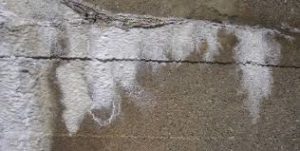Being “wet behind the ears” refers to an individual’s inexperience or naiveté. In our 23 years of garage floor coating experience, we’ve seen many contractors and DIYers that would qualify. Failure at mitigating moisture is one of many examples. Moisture mitigation is incredibly important in floor coatings application. Yet so many installers don’t take this into account. Whether it’s lack of experience, lack of technical knowledge or poor judgment, not mitigating moisture in concrete will seriously affect the life of your flooring.
Inexperienced Contractors & DIY Kits
In a vastly overcrowded floor coatings market, inexperienced contractors and DIYers abound. The former hypes “1-day” polyurea-polyaspartic systems and the latter uses hardware store DIY kits. So many coating companies are telling their customers that these 1-day polyurea polyaspartic systems are a magic bullet. Quick and cheap, right? Well, we like to say “Buyer beware”.
1-Day Polyurea-Polyaspartic Flooring Systems
Under certain conditions, the use of 1-day polyurea-polyaspartic systems may be perfectly acceptable. But this is the exception rather than the rule. To apply polyurea-polyaspartic direct to concrete, the measured moisture in the concrete must be very, very low. And by measured, I mean taking multiple readings of moisture levels using a calibrated moisture meter. Polyurea-polyaspartics are better served as second (color) coats and clear coats. And not as the primer coat direct to concrete as 1-day systems do.
The reality? 1-day coating systems just don’t meet commercial specifications. Aside from the inability to mitigate moisture, these simple 2-coat systems use far less material. About half the “millage” of a commercial-grade installation. The result is that “1-day” polyurea-polyaspartic flooring systems are less durable.
So why would a contractor hype a “1-day” flooring system? Because less material and less labor equals more profit. If your prospective installer suggests a “1-day” polyurea polyaspartic system without first measuring the moisture in your concrete floor, let the buyer beware!
Check out these articles for further information on polyaspartics:
https://www.concretenetwork.com/polyaspartic-floor-coatings/
https://www.concretenetwork.com/polyaspartic-floor-coatings/comparison.html
Why Assess Moisture in Concrete?
Assessing moisture is one of the most important pre-installation steps! The most common problem associated with the peeling (“delamination”) of epoxy and polyurea-polyaspartic floor coatings is high moisture content.
As with all concrete, water vapor gets trapped under the concrete slab. Because epoxy and polyurea-polyaspartic coatings create an impenetrable moisture barrier, a hydrostatic pressure builds with sufficient force to lift the coating right off the surface.
And then we get a call. Many of our jobs are “removal and re-coats” of previously painted or polyurea-polyaspartic-coated concrete floors. Most re-coats simply haven’t been properly assessed for moisture.
So what do we do?
Well, other than looking for the telltale signs of moisture including efflorescence (the migration of salt to the surface of porous concrete) and dark spots, we always use a calibrated moisture vapor transmission meter to assess the moisture level of the concrete to be coated. Multiple readings in fact, at least 3 per 100 square feet.
If the any of the readings are high, we select our moisture-mitigating hydro epoxy as our primer coat. Two-component hydro epoxies provide deep substrate penetration and mitigate substrate moisture problems (due to hydrostatic pressure).
The problem? Once a moisture-mitigating hydro epoxy is selected for application as the primer coat, installation becomes a 2-day process…at best. In the vast number of cases, you simply can’t use a 1-day polyurea-polyaspartic system without sacrificing quality.
The Wrap
Be vigilant of “1-day” polyurea-polyaspartic hype. And stay away from the standard DIY epoxy kits and get real professional help. Moisture mitigation is extremely important. Not assessing for moisture and applying the wrong product direct to concrete can be a very costly mistake.
*Image credit for header – https://concretesealerreviews.com/does-a-water-repellent-truly-repel-water/
About the Author
Share this Post






